Impact Factor : 0.548
- NLM ID: 101723284
- OCoLC: 999826537
- LCCN: 2017202541
Rana SS*1 and Bansal GL2
Received: December 01, 2017; Published: December 07, 2017
Corresponding author: S S Rana, Department of Agronomy, CSK HP Agricultural University, Palampur 176 062, HP India
DOI: 10.26717/BJSTR.2017.01.000573
A novel technique of converting decomposable organic wastes into valuable manure (compost) through earthworm activity is a faster and beneficial process. The earthworms are used as the natural bioreactors for making decomposition of the waste materials. Keeping in view the vast availability of organic wastes in Himachal Pradesh, a project was undertaken in tribal areas of the state to train women for dissemination of the technology and their economic upliftment. The study was conducted in two districts of Himachal Pradesh viz. Kinnaur and Lahaul & Spiti. From these two districts 68 villages were randomly selected (27 in Kinnaur and 41 in Lahaul and Spiti) and 858 farm families (371 in Kinnaur and 487 in Lahaul & Spiti) were approached through a pre-tested interview schedule. The independent variables selected for the study were educational status, annual income of the family, size of land holding, cattle population, organic waste, crop husbandry information, manures and pesticides used. The population engaged in agriculture was 86.5, 80.5 and 50.2% in Kinnaur, Lahaul and Spiti, respectively. Due to the cultivation of cash crops such as apple, pea, potato, rajmash etc. income of the tribal families was satisfactory especially in Kinnaur. However, in Lahaul and Spiti 85.5 and 100% farm families fall under low income group.
Crop residues were available in Kinnaur. In Kinnaur, Lahaul and Spiti only 53.2, 43.8 and 16.5%, respectively, of the families were using insecticides. The respective use of fungicides in these areas was by 85.4, 91.5 and 56.7% families. None were using herbicides in Kinnaur, while 61.5 and 47% families were using in Lahaul and Spiti, respectively. In Kinnaur, Lahaul and Spiti 97.9, 95.5 and 96.9% of the total families were rearing cows. Thus after crop husbandry, animal husbandry/dairying is the other important activity taken up by the tribal farmers. In Kinnaur, Lahaul and Spiti quite a satisfactory amount of waste was available for this activity being taken up in a big way in the area. The kitchen waste in villages is directly fed to the livestock reared by the farmers. In total, 30 training programmes were organized in far flung and difficult to reach villages, where 1245 tribal women farmers were trained and 175 vermicomposting units were set up. The vermiculture were distributed free of cost for these units. The participation in State Tribal Festival at Rekangpeo helped in spreading vermitechnology activity to about 5000 tribal farmers. These studies were a step for tribal/rural development for providing balanced nutrients for enhanced crop productivity as well as a source of earning a rural livelihood.
Keywords: Vermitechnology; Rural Livelihood; Survey; Training; On-Farm Trials
India produces about 3,000 million tons of organic wastes annually which could be utilized for recovering important resources like manures, fuel, food and fodder. Beside biogas and alcohol, this huge amount of waste has also the potentiality to produce 400 million tonnes of plant nutrients Dash and Senapati [1]. A novel technique of converting decomposable organic wastes into valuable manure (compost) through earthworm activity is a faster and beneficial process. The earthworms are used as the natural bioreactors for making decomposition of the waste materials. In whole of Himalayan region in general and tribal belt in particular, the majority of agricultural operations are carried out by women, where as men mostly engaged in earning livelihood, procuring agricultural inputs and marketing of the agricultural produce. Keeping in view the vast availability of organic wastes in Himachal Pradesh and involvement of women in agriculture, a project was undertaken in tribal areas of the state to train women for dissemination of the technology and their economic upliftment.
As desired by the sponsoring agency, the study was conducted in two districts of Himachal Pradesh viz. Kinnaur and Lahaul & Spiti. From these two districts 68 villages were randomly selected (27 in Kinnaur and 41 in Lahaul and Spiti) and 858 farm families (371 in Kinnaur and 487 in Lahaul & Spiti) were approached through a pretested interview schedule. The independent variables selected for the study were educational status, annual income of the family, size of land holding, cattle population, organic waste, crop husbandry information, manures and pesticides used. The training camps (one day, off campus and on-campus) have been organized by involving village gram pradhans, Mahila mandal Pradhans and the self help groups. The Pradhans of these two democratic village bodies as well as SHG’s in many of training programmes were fully involved in training programmes, establishment of vermitechnology units and culture distribution to tribal women farmers. Farmers have been distributed literature on the technology and after care of the units so established. The follow up visits were also conducted to see the success of units so established, feed back and further educating the farmers. The on-farm trials on rajmash were conducted in Kinnaur whereas on pea in Lahaul.
The majority of the population in the tribal belt was engaged in agriculture including horticulture for their livelihood. The population engaged in agriculture was 86.5, 80.5 and 50.2% in Kinnaur, Lahaul and Spiti, respectively (Table 1). This was the major strength, for success of the vermicomposting activity to be taken up in the tribal belt. The majority of the tribal area remains covered with snow in winter, and crops are not grown in the field during that period. Therefore, weaving is the next major activity taken up by 7.9, 7.0 and 46.1% of the surveyed families in Kinnaur, Lahaul and Spiti, respectively. Majority of the population was illiterate or below matrix which was mostly engaged in agriculture or horticulture.
Table 1: Occupation, education, annual income, land holding, manures and nutrients and pesticides used.
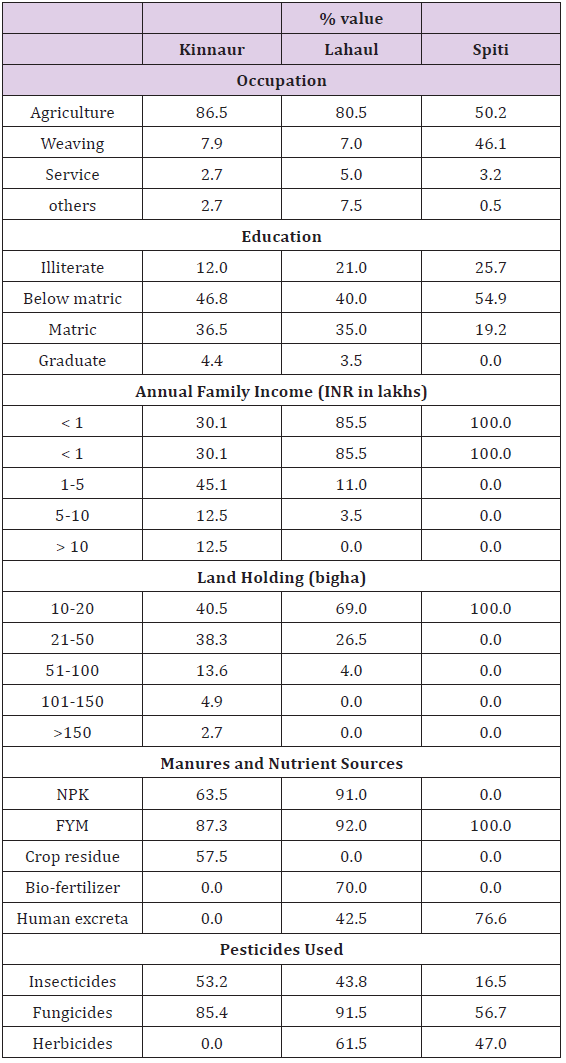
1 bigha = 800m2
Due to the cultivation of cash crops such as apple, pea, potato, rajmash etc. income of the tribal families was satisfactory especially in Kinnaur. However, in Lahaul and Spiti 85.5 and 100% farm families fall under low income group. Since vermicomposting is a low investment requiring activity, indicating self reliance on the part of the farmers for this activity to be taken up independently provided technical know-how given. Operational/owned land holding size was also satisfactory and all the surveyed families possessing more than 10bighas (1bigha= 0.08ha) of land. This indicated that besides taking Vermicomposting as a livelihood enterprise, the produce (vermicompost) is itself required by the farm family for its own use in the farm.
Majority of the families use FYM as a source of nutrients produced either by themselves or through purchase. Crop residues are also available in Kinnaur. In Lahaul and Spiti 42.5 and 76.6% of the population were also using human excreta as a source of nutrients in their fields. In Spiti, none of the families were found using fertilizers. However, in Kinnnaur and Lahaul 63.5 and 91.0% of the families were using commercial fertilizers. But in Kinnaur, fertilizers being used were much below the optimum level that too in the cash crops especially apple. If organic farming is to be taken up, the area has to be withdrawn completely off the pesticides use as these are used indiscriminately. In Kinnaur, Lahaul and Spiti 53.2, 43.8 and 16.5% of the families were using insecticides and 85.4, 91.5 and 56.7% families were using fungicides. None were using herbicides in Kinnaur, while 61.5 and 47% families were using herbicides in Lahaul and Spiti, respectively.
Majority of the population was rearing quite a satisfactory number of cattle (Table 2) as large number of area was available for grazing. Stall feeding was done only in winter or for milch animals. In Kinnaur, Lahaul and Spiti 97.9, 95.5 and 96.9% of the total families were rearing cows. Thus after crop husbandry, animal husbandry/dairying was the other important activity taken up by the tribal farmers. Topography of whole of the study area and thus the cultivated fields were undulating. As such the mechanical cultivation of the fields was possible only to a limited extent for which the efforts are yet to be geared. So plouging and such other operations in the field were done using bullock power. 50% of the families in Kinnaur and 65.4% each in Lahaul and Spiti were possessing bullocks by themselves for cultivating their fields and supply of manures. Sheep and goat rearing was also taken up by quite a large number of populations especially for wool and meat purposes. Yaks were reared by more than 50% of the surveyed population in Spiti and by less than 1% population in Kinnaur. The manure obtained from this large number of animal population was by and large not properly composted; rather it was dried for reducing the weight for easy carrying in the difficult terrain and fields located away from the villages. Vermitechnology in this endeavourer play a pivotal role improving upon the quality of the compost as well as reduction in weight for easy carrying Bansal and Rana [2].
Table 2: Cattle population.
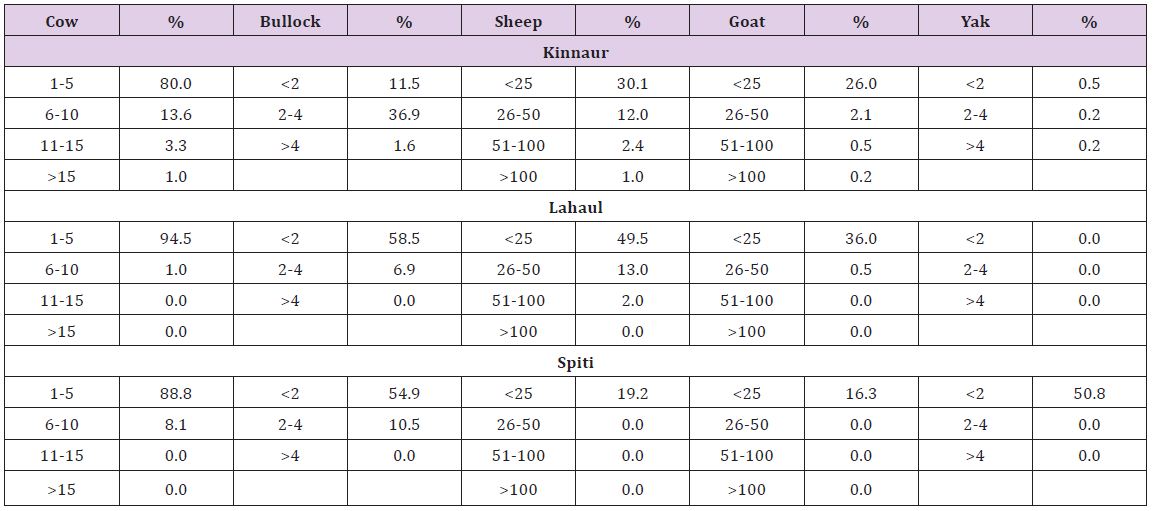
In Kinnaur, Lahaul and Spiti quite a satisfactory amount of waste was available for this activity being taken up in a big way in the area (Table 3-5). However, in none of the districts kitchen waste was available for using in vermicompost preparation. The kitchen waste in villages was directly fed to the livestock reared by the farmers.
Table 3: Organic waste.
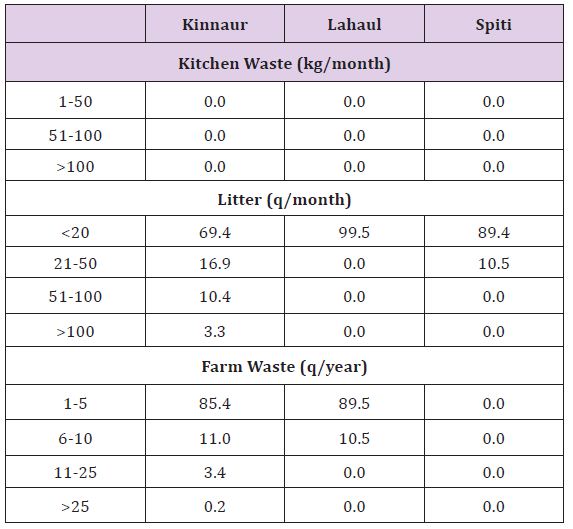
Table 4: Crop husbandry (Percent farm families).
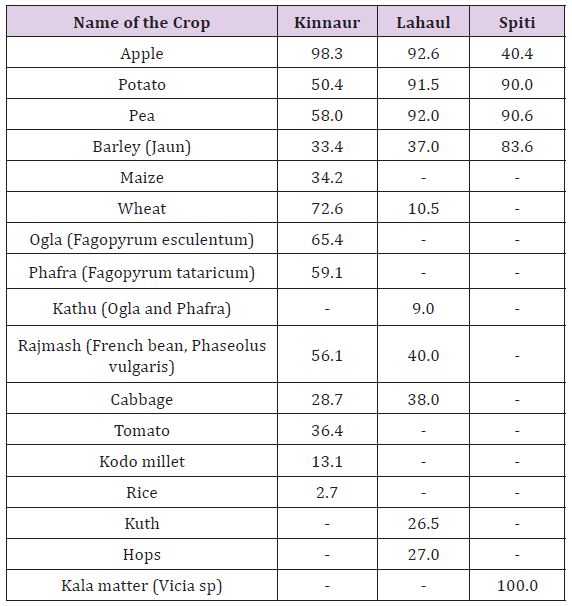
Table 5: Vermitechnology Training Programme organized and the women trained during 2006.
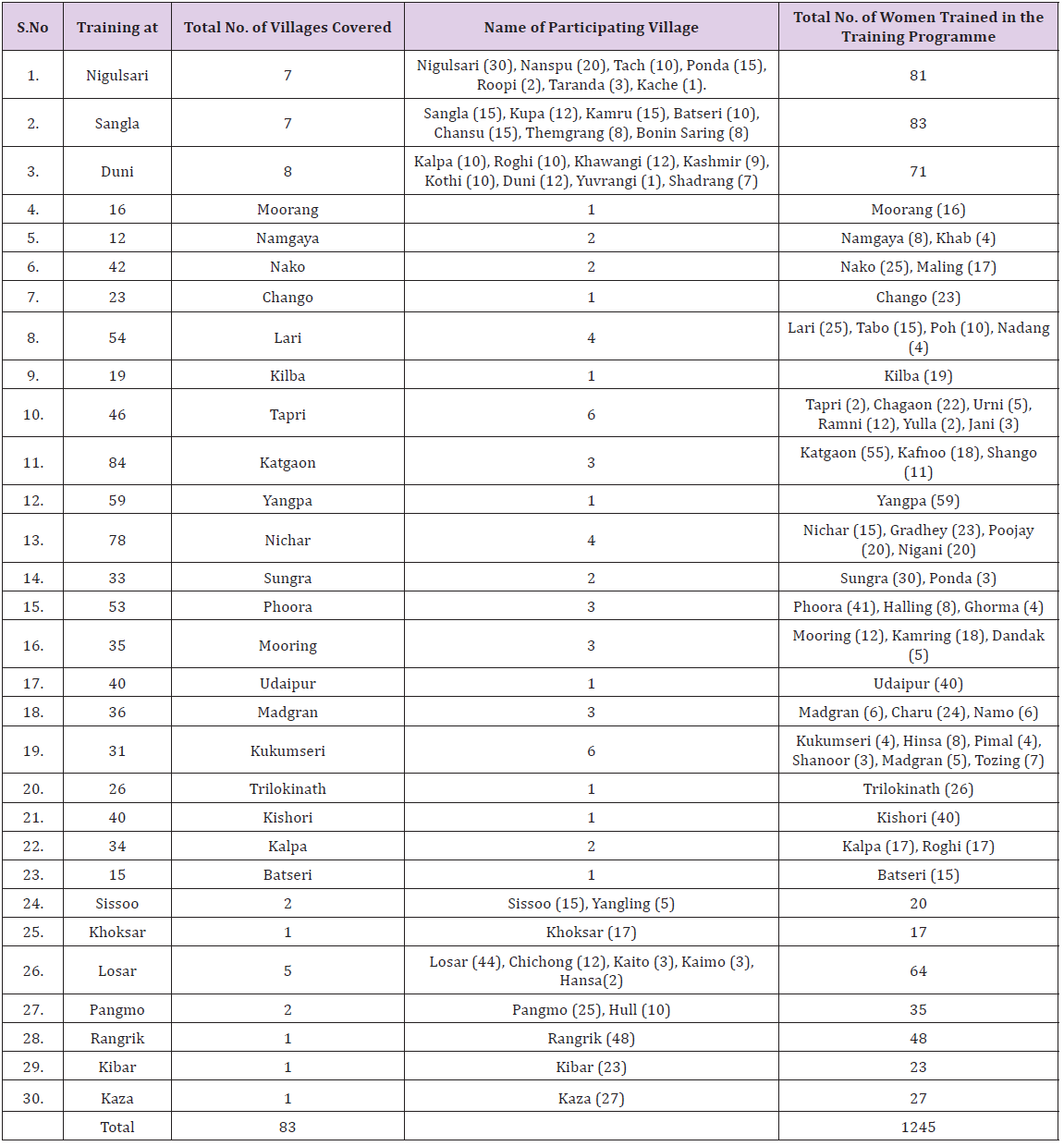
Being high altitudes, the larger area in the tribal belt remains under snow in winter and one or at the most two crops in a year was a common feature of cropping. Crops were grown in summer except in the lower reaches of Kinnaur. The crops grown in plains during winter also find place in summer in the tribal area. The off-season produce of the crops like pea, French bean, potato fetches premium prices in the plains. Only a few crops were grown but diversity was greater in Kinnaur followed by Lahaul. However, in Spiti, five crops were mainly grown. Keeping in consideration, the vast availability of raw material for the production of vermicompost, resources and man power available, the efforts were initiated to educate the women through training camps, establishing composting units on the participatory mode, distributing brochures and pamphlets, and organizing activities such as ‘vermin mela’ etc.
Twenty four one day vermitechnology training camps were organized where women from 83 villages participated. In all 1245 women farmers were trained about organic farming, organic waste recycling and importance and use of vermicompost. The farmers were educated about the importance of utilization of organic/ agricultural waste for conversion into valuable compost through vermicomposting which otherwise was burnt considering it an absolute refuse.
176 vermitechnology/vermicomposting units were established with the precondition of the availability of the crop residues/ animal waste and to those who evinced keen interest in the camps. The complete list of farmers under whose disposal the activity undertaken is available with the authors. Three demonstration units were also set up one each at the main campus Palampur, HAREC, Kukumseri and HAREC, Sangla.
One bilingual “Vermicompost: Agricultural Gold from Garbage” a 24 page brochure with coloured pictures was brought out. The brochure describes technology through pictures, sources of nutrients, species of earthworms to be used, preparation of compost bed, raw materials, filling of bed, collection of vermicompost, precautions, advantage of vermicompost, usage and how it can be a micro-enterprise for women. Another 4 page pamphlet was also brought out in Hindi describing vermitechnology in simple language, raw materials to be used, bed preparation, collection of compost, its uses and usages.
Participated in the State Tribal Festival at Recongpeo and set up a stall depicting vermitechnology for the tribal farmers. The setting up of stall was a great success where about 10,000 farmers who visited the stall were sensitized about the production and use of vermicompost from farm organic wastes. The stall was declared second in order of merit and has been awarded a cash prize of INR 1500/-. From the follow up visits in all the villages, it has been observed that Pradhans and farmers were taking interest in vermicomposting and units were working well. In many villages farmers have started using vermicompost so obtained for crop cultivation/in orchards. The technology was a great success in future as per the results in the first year.
The on-farm trials were conducted on French bean in district Kinnaur (Table 6). The data were received from five trials/ locations. The perusal of data revealed that 50% N through FYM + 50% through vermicompost and 100% N through Vermicompost remaining at par, resulted in significantly higher seed yield of French bean over rest of the treatments. 50% N through FYM + 50% through vermicompost and 100% N through vermicompost increased seed yield of French bean by about 50 and 44 percent over the farmers’ and recommended practices. The on-farm trials on pea were conducted in Lahaul (Table 7). The data were received from five trials/locations. The perusal of data revealed that the integrated nutrient management teatments remaining at par with recommended application of nutrients resulted in significantly higher yield of pea over farmers practice. The findings of the present investigation conclusively inferred that vermitechnology is an effective strategy to increase yield and enhance the profitability of the tribal women. The different extension approaches followed to make abreast a small proportion of the tribal women need to be replicated in rest of the area to strengthen the livelihood security of rest of the population.
Table 6: Effect of treatments on yield of French bean (Rajmash).

Table 7: Effect of treatments on yield of Pea (kg/ha).



